How the British Government Responded to the Great Hunger
In January 1847, the Nation published a poem entitled ‘The Stricken Land.’ It was a searing indictment of the policies of the British Government in the wake of the second failure of the potato crop only a few months earlier. It was written by a young woman, Jane Elgee, who was drawn from the Protestant Ascendancy, but who became a member of a group of radical nationalists known collectively as ‘Young Ireland.’ She wrote using the pen-name, ‘Speranza.’
Weary men, what reap ye?–Golden corn for the stranger.
What sow ye?—Human corpses that wait for the avenger.
Fainting forms, hunger-stricken, what see you in the offing?
Stately ships to bear our food away, amid the stranger’s scoffing.
They guard our masters’ granaries from the thin hands of the poor.
Pale mothers, wherefore weeping?–Would to God that we were dead–
Our children swoon before us, and we cannot give them bread …
We are wretches, famished, scorned, human tools to build your pride,
But God will yet take vengeance for the souls for whom Christ died.
Now is your hour of pleasure–bask ye in the world’s caress;
But our whitening bones against ye will rise as witnesses,
From the cabins and the ditches, in their charred, uncoffin’d masses,
For the Angel of the Trumpet will know them as he passes.
A ghastly, spectral army, before the great God we’ll stand,
And arraign ye as our murderers, the spoilers of our land.
These words, even from the eloquent pen of Speranza [mother of Oscar Wilde], did not do justice to the desolation and horror of the period of devastation remembered as ‘the Great Hunger.’ Like other famines, the Irish Famine was not solely the consequence of food shortages but resulted from political decisions that made the suffering of the poor secondary to economic greed, political ambition, and ideological prejudice. In 1997, the then British Prime Minister, Tony Blair, belatedly acknowledged that the all-powerful British government had ‘stood by’ while the Irish people starved. What occurred in the years after 1845 was more complex, although no less reprehensible or tragic.
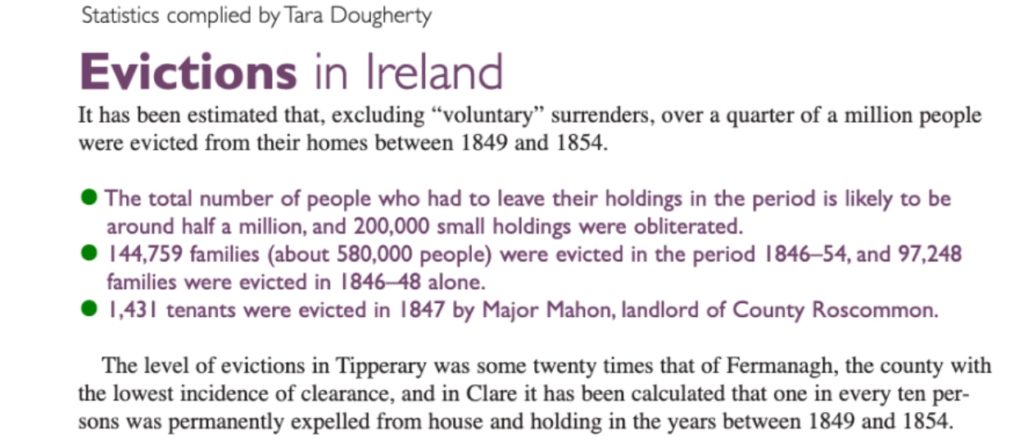
As a consequence of the Act of Union of 1800, by the 1840s England, Ireland, Scotland and Wales were governed by a single parliament based in Westminster in London. Despite Ireland accounting for almost half of the population within the United Kingdom, she sent only 105 members (from a total of over 600) to the London-based parliament, and they tended to be divided along political lines – belonging to the Tory (Conservative), Whig or Repeal Parties. In 1841, Sir Robert Peel, leader of the Conservatives, had won a massive electoral victory. One of his main political adversaries was Daniel O’Connell, leader of the Irish Repeal Party, who aimed to overturn the Act of Union by legal and constitutional means. In 1845, when a mysterious and previously unknown blight destroyed approximately forty percent of the Irish potato crop, a repeal of the Union appeared no closer to being achieved.
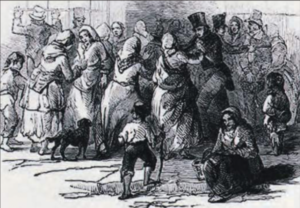
Moreover, O’Connell, increasingly incapacitated by age and illness, was no longer the political force that he had been. As the potato crop failed repeatedly, the Irish poor became increasingly dependent on policies made in London to save their lives.
In the first year of shortages, nobody died of famine in Ireland. The lack of excess mortality was attributed to the quick and comprehensive response by the Conservative government of Sir Robert Peel. At the same time, however, from the outset relief policies were combined with attempts to bring about social change in Ireland, including ending the dependence of the poor on the potato, and getting rid of landowners who were judged to be unenterprising. Overall, potato cultivation and dependence was regarded as perpetuating the perceived backwardness of the Irish economy and its people. In the words of Sir Randolph Routh, who had overall responsibility for the relief operations:
“The little industry called for to rear the potato, and its prolific growth, leave the people to indolence and all kinds of vice, which habitual labour and a higher order of food would prevent. I think it very probable that we may derive much advantage from this present calamity.“
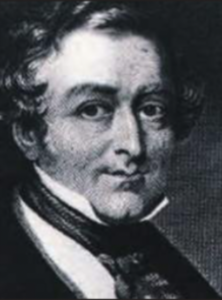
Overall, therefore, the policies introduced in the first year of shortages reflected the government’s longer-term aspirations for Ireland. Peel also used the potato failure to repeal the Corn Laws, which has kept the price of grain products artificially high. However, Peel himself became a political casualty of the Famine as many landowners in his party abhorred his action in repealing the Corns Laws. As a consequence, a minority Whig government headed by Lord John Russell assumed power in the summer of 1846, just as news of the reappearance of the blight was emerging. The fact that the disease appeared earlier in the harvest season than in the previous year had ominous implications for the potato crop.
In 1846, almost the entire potato crop was destroyed; moreover, the corn harvest was smaller than usual. A second, and more extensive, year of food shortages was inevitable. Yet, regardless of this, the program of relief introduced by Russell’s administration was more restrictive than that of the previous year. Public works were the primary form of relief, but the way in which this form of relief was provided made them unsuitable to provide effective support to a hungry people. Numerous bureaucratic checks were imposed, which meant the works were slow to be established; wages were based on ‘piece work’, disadvantaging people who were already weakened by hunger; a wages ceiling was imposed despite spiraling food prices; furthermore, the works undertaken were to be of no value to the community but were simply intended to act as a test of genuine destitution. Consequently, the people who did manage to get employment on the public works (and not everybody did) were occupied in hard physical labor, usually for twelve hours a day, engaged in useless projects — building roads that led nowhere and walls that surrounded nothing. The fact that the winter of 1846-1847 was one of the coldest on record, with snow falling as late as April, added to the misery and vulnerability of those so employed.
By the end of 1846, there was a sharp increase in mortality. As in any famine, hunger-induced disease rather than starvation was the main source of mortality. For the victims, death was slow, painful and undignified. One of the main causes of death was dysentery, which caused aching in the legs, arms and head, a swelling of the limbs, and an inability to keep anything in the stomach. A doctor in Skibbereen in County Cork, which was to achieve notoriety for the suffering of its population, recorded that ‘all talk of exaggeration is at an end. The people are dying – not in twos or threes – but by dozens; the ordinary forms of burial are dispensed with.’ In the winter of 1846-47 excess mortality increased throughout Ireland, from Skibbereen to Belfast. No part of Ireland escaped the horror of the situation. A member of the Society of Friends who visited Lurgan, near Belfast, in the spring of 1847, likened what he saw to the worst scenes that he had witnessed in County Cork.
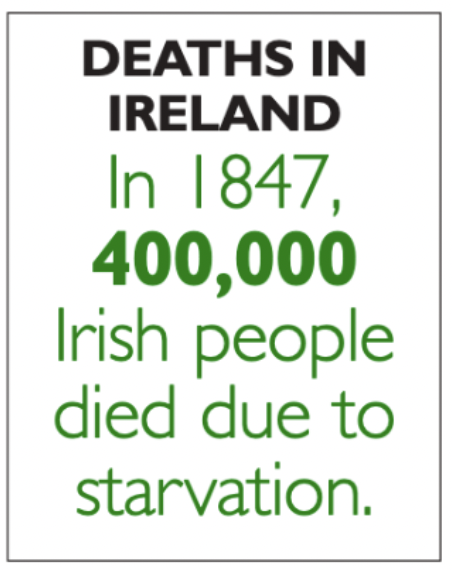
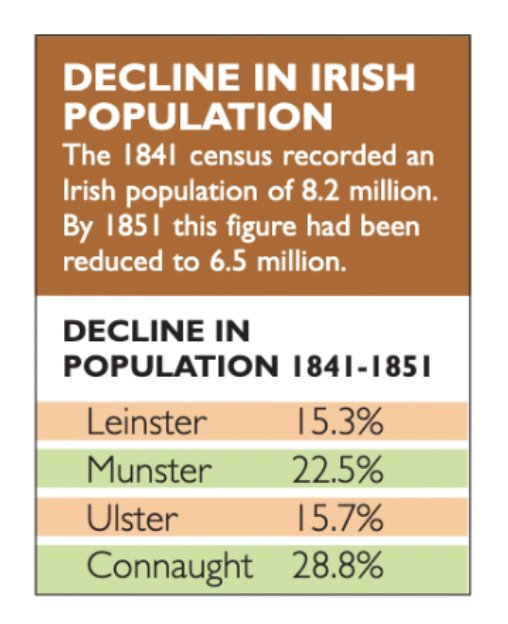
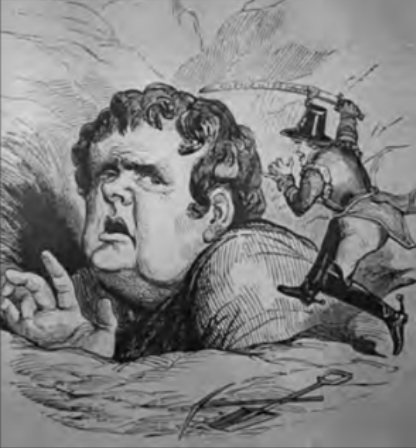
The British parliament was fully aware of the deathly situation unfolding in Ireland. At the beginning of 1847, Lord George Bentinck, leader of the divided Tory Party, had led a sustained attack on the Whig Party, pointing to the deteriorating situation in Ireland. Bentinck, supported by Benjamin Disraeli, condemned many aspects of the Whig government’s relief policies, including the fact that they had reduced the size of rations to the Irish poor, they had left food importation to private traders and speculators, and they had exaggerated the quantity of foodstuffs imported into Ireland. Apart from censuring the government for allowing such high mortality, he criticized the fact that records of famine deaths were not being kept. He repeatedly protested that it was within the capability of the British government to do so.
At the beginning of 1847, the British government decided to close the public works; not because they were failing to save lives, but because they were expensive and cumbersome to administer. At this stage, 15,978 people had been employed, at a cost of £410,000; meanwhile, the cost of providing relief for less than six months had reached four and a half million pounds, most of which was provided as a loan to the Irish tax-payers. Yet, despite this high expenditure, the public works had not only failed to save lives, but had exacerbated existing problems; the works had diverted people from their normal agricultural pursuits, while requiring vast amounts of energy from an exhausted and hungry population.
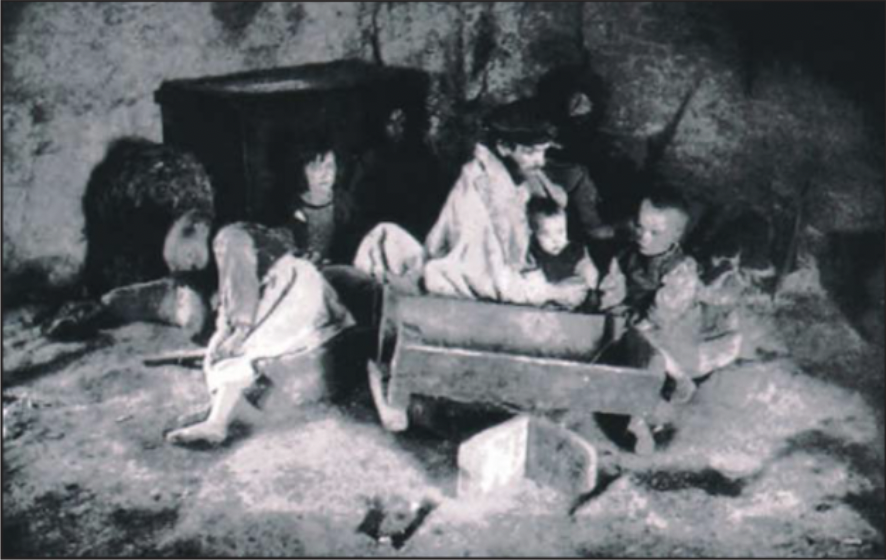
To replace the public works, a Temporary Relief Act, popularly known as ‘the soup kitchen act’ was introduced. As its name suggested, it was to be an interim measure, until the Poor Law could be modified to enable it to provide for both ordinary and famine relief. The soup kitchens marked a break from earlier relief provisions, which had viewed the giving of gratuitous relief to be both ideologically flawed and financially perilous. The soup kitchens, however, despite the paucity and lack of nutrition of some of the food provided, marked a highpoint in famine relief. By July 1847, over three million people (approximately forty percent of the population) were receiving free, daily rations from their local soup kitchen, at relatively little cost. This short-term measure demonstrated that it was both logistically and financially possible to feed the Irish poor. Politically, however, such a solution was unacceptable. There was a general election in the United Kingdom in the summer of 1847, which was won by the Whigs. One of the first acts of the new government was to oversee the introduction of an amended Poor Law, which made the much-detested workhouse system the main provider of relief, and meant that the famine poor were now to be classified as ‘paupers’. More significantly, responsibility for financing relief was to pass to local Irish rate-payers through the mechanism of local Poor Law taxation.
The question of food exports and imports also proved to be controversial. Prior to 1845, Ireland had been a major exporter of food to Britain, including vast amounts of high-quality grain products, earning it the title of ‘the bread basket of the United Kingdom’. Following the failure of the potato crop, many within Ireland, including the corporations of Dublin, Cork, Limerick and Belfast, had asked the government that the ports be closed to allow foodstuffs to remain within the country. Similar measures had been used during earlier periods of food shortages and had proved to be effective. Moreover, other governments in Europe were responding to crop shortages in their own countries by acting to keep food within their country, as a way of increasing supplies and stabilizing prices.
The British government, which at the time was one of the most interventionist in the world, refused to do so, arguing instead the efficacy of non-intervention and laissez-faire. Consequently, massive amounts of foodstuffs left Ireland, even from impoverished areas such as Dingle, Killala and Kilrush, while inadequate amounts of highly-priced, generally low-quality, corn was imported. The senselessness of the situation was explained by the Nation:
“Let us explain to you Irish farmer, Irish landlord, Irish tradesman, what became of your harvest, which is your only wealth? Early in the winter it was conveyed, by the thousand shiploads, to England, paying freight; it was stored in English stores, paying storage; it was passed from hand to hand among corn-speculators, passing at every remove, commission, merchants’ profits, forwarding charges and so forth; some of it was bought by French or Belgian buyers and carried to Havre, to Antwerp, to Bordeaux, meeting on the way other corn, from Odessa or Hamburg or New York, which also earned for merchants, ship-owners and other harpies, immense profits, exorbitant freights, huge commissions … In other words, you sent away a quarter of wheat at 50 shillings, and got it back, if you got it at all, at 80 shillings.”
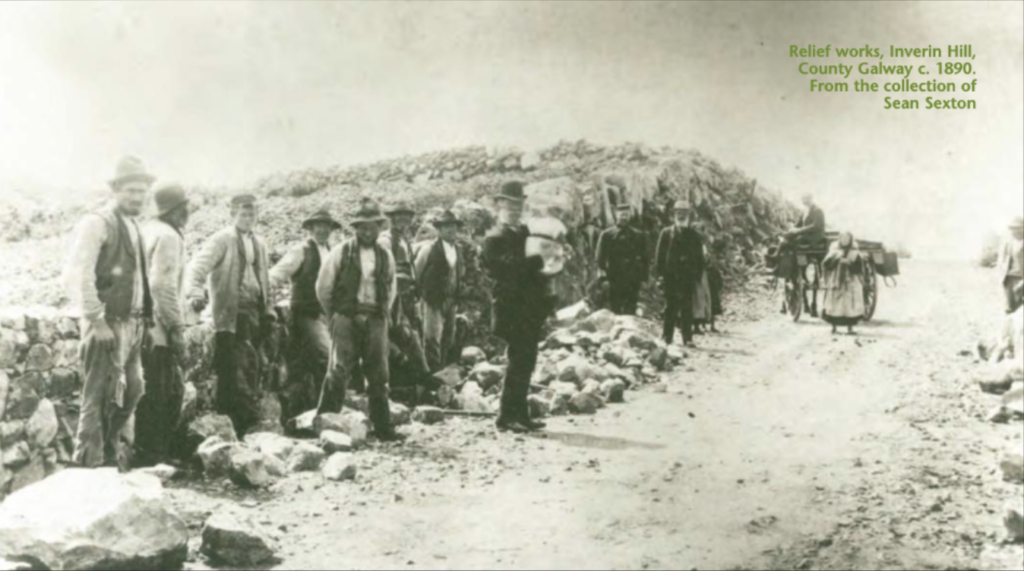
Criticism of this policy was not confined to nationalists. The Lord Lieutenant of Ireland, the Earl of Clarendon, a political ally of the British Prime Minister, wrote to him in private, making it clear that he believed the Irish poor had been the victims of the greed of the merchants and the political ambitions of John Russell: ‘No-one could now venture to dispute the fact that Ireland had been sacrificed to the London corn-dealers because you were member for the City, and that no distress would have occurred if the exportation of Irish grain had been prohibited’.
Belatedly in 1847, the government temporarily removed the restrictive Navigation Acts, which had limited the ability of foreign-registered ships to bring goods to the ports of the United Kingdom. This measure was too little and too late. In 1847, the British government had used public works, soup kitchens and the Poor Law as a way of dealing with the crisis, but the high cost of food and the draconian way in which relief had been provided had added to the problems of the poor. Morality and suffering in 1847 earned the year the enduring sobriquet, ‘Black ’47’. However, this year marked neither the apogee nor the end of the suffering in Ireland.
The decision to leave Ireland to its own resources following the harvest of 1847 proved to be disastrous. It also demonstrated that the Act of Union, enforced on Ireland only fifty years earlier, meant little in reality. For members of Young Ireland, the failure of both the Irish landlords and the British government to protect the lives of the poor pushed them reluctantly to a path of rebellion, culminating in small, unsuccessful rising in Ballingarry in July 1848. However, nationalists were not the only people dismayed at the seeming indifference of the British government to the Irish poor. In October 1847, the Earl of Clarendon, wrote to the Chancellor of the Exchequer, Charles Wood:
“I hope Lord John Russell will not persist in his notion that Irish evils must find Irish remedies only, for it is impossible that this country will get through the next eight months without aid in some shape or another from England –it may be very difficult – very disagreeable. Irish ingratitude may have extinguished English sympathy, and the poverty of England may be urged against further succor to Ireland, but none of these reasons will be valid against helpless starvation.”
Clarendon’s warnings were unheeded, with many politicians in London continuing to justify minimal intervention by laying the blame for the situation on the Irish poor themselves, their laziness and their ingratitude. Clearly, the Irish people were not regarded as equal partners with the Union even at a time of crisis.
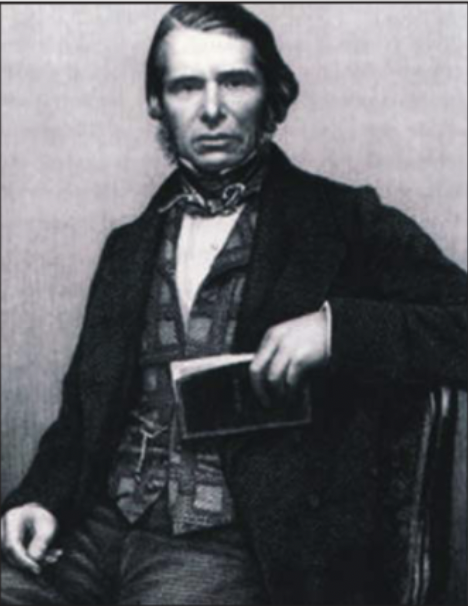
After 1847, hunger and disease were compounded by the increasing problem of homelessness. The tax burden imposed by the amended Poor Law had created an incentive for landlords to evict tenants, while the draconian ‘Quarter Acre Clause’ had forced tenants with small plots of land to make the stark choice between giving up their holdings or facing starvation. At the same time, the additional responsibilities placed on the Poor Law proved to be untenable in a number of unions, forcing them to stop providing relief, or doing so at an inadequate level. Faced with a deteriorating situation the government, through the channel of Charles Trevelyan, the scrupulous, but parsimonious Secretary of the Treasury, made small, piecemeal grants to unions considered to be most in need. Again, Clarendon made his colleagues aware of the consequences of this policy, warning that the outcome would be ‘wholesale starvation’ that would not only be ‘shocking, but bring deep disgrace on the government’.
The unpopularity of giving even small amounts of assistance to Ireland resulted in a further change in policy – but one that confirmed the desire to make Irish suffering a burden on Irish tax-payers. In 1849, the ‘Rate-in-Aid’ was introduced. It provided for a fixed tax to be placed on each Poor Law union in Ireland, which would then be redistributed to the poorest unions by Trevelyan. The new tax conformed to the principle that the tragedy was an Irish, not an imperial, responsibility. The new tax was unpopular throughout Ireland, but was especially disliked in the northeast of the country, which was recovering from the Famine, helped by a revival in the linen industry. The strongest opposition to the new tax, however, came from two Englishmen, close to the government. Clarendon believed that it undermined the idea of a United Kingdom, and would serve to increase support for separation from Britain. While Edward Twistleton, who had been the Irish Poor Law Commissioner since 1847, resigned in 1849 on the ground that the tax was an unfair burden on Ireland, which he could not implement ‘with honour’.
Over the previous two years he had disagreed frequently with the policies he was overseeing, and had had many angry encounters with Charles Trevelyan over the parsimony with which the Treasury had released funds. Before leaving office, he informed Trevelyan that as he and his colleagues had repeatedly been denied sufficient funding, they were ‘absolved from any responsibility on account of deaths which may take place on account of those privations.’ A few weeks later, he told a parliamentary committee that deaths, even in the poorest unions, could have been prevented ‘by the advance of a few hundred pounds.’
The 1849 harvest was blight-free in many parts of Ireland, and industry, especially the linen trade, was reviving. Yet in some parts of the country the recovery was slow and partial, with mortality and emigration being even higher in 1849 and 1850 than they had been in 1847. The deteriorating conditions in the Kilrush Union in County Clare led to an official enquiry, which found that the union had lost approximately fifty per cent of its population since 1846. The Commissioners believed that the local poor had been doubly abandoned – by their landlords and by the British government. They concluded their report by saying:
“Whether as regards the plain principles of humanity, or the literal text and admitted principle of the Poor Law of 1847, a neglect of public duty has occurred and has occasioned a state of things disgraceful to a civilized age and country, for which some authority ought to be held responsible, and would long since have been held responsible had these things occurred in any union in England.”
This report, as did the private and public comments made by English officials including Bentinck, Clarendon and Twistleton, revealed the diversity of response to the Famine within the British establishment. In the end though, it was men lacking vision and compassion who determined how the British government responded to the unfolding tragedy. The political cost of reacting in this way proved to be high, but the human cost – which extended far beyond the numbers who died or emigrated – remains incalculable.

Editor’s Note: This article was originally published in Irish America’s June/July 2010 Issue.


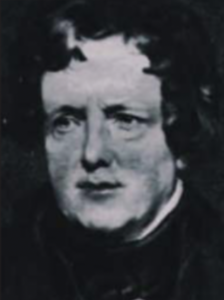
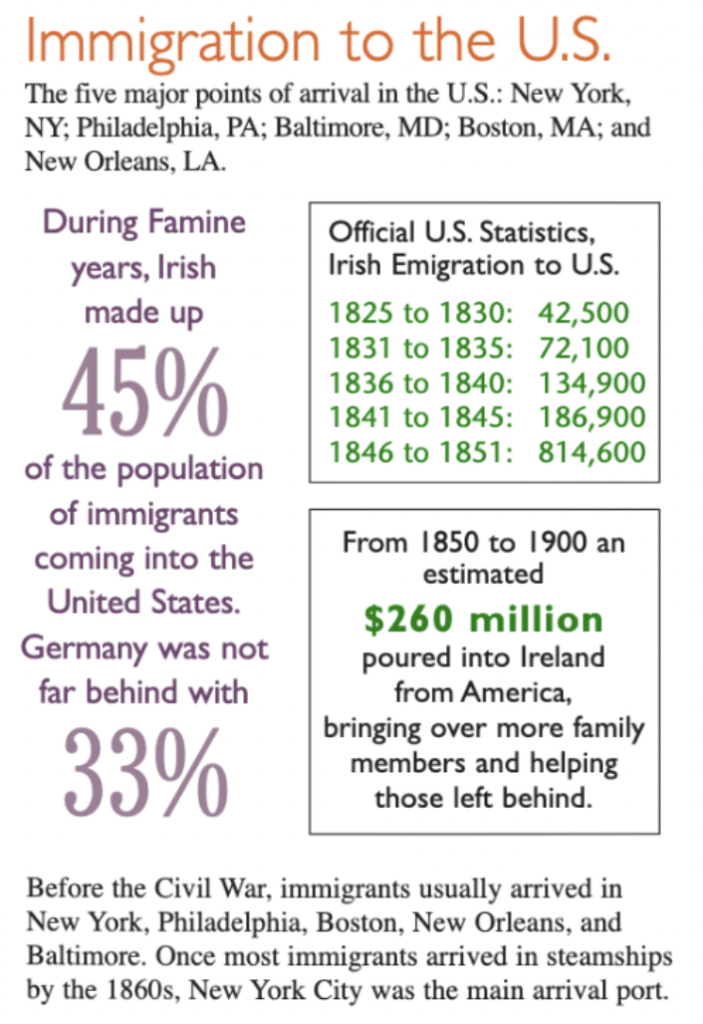
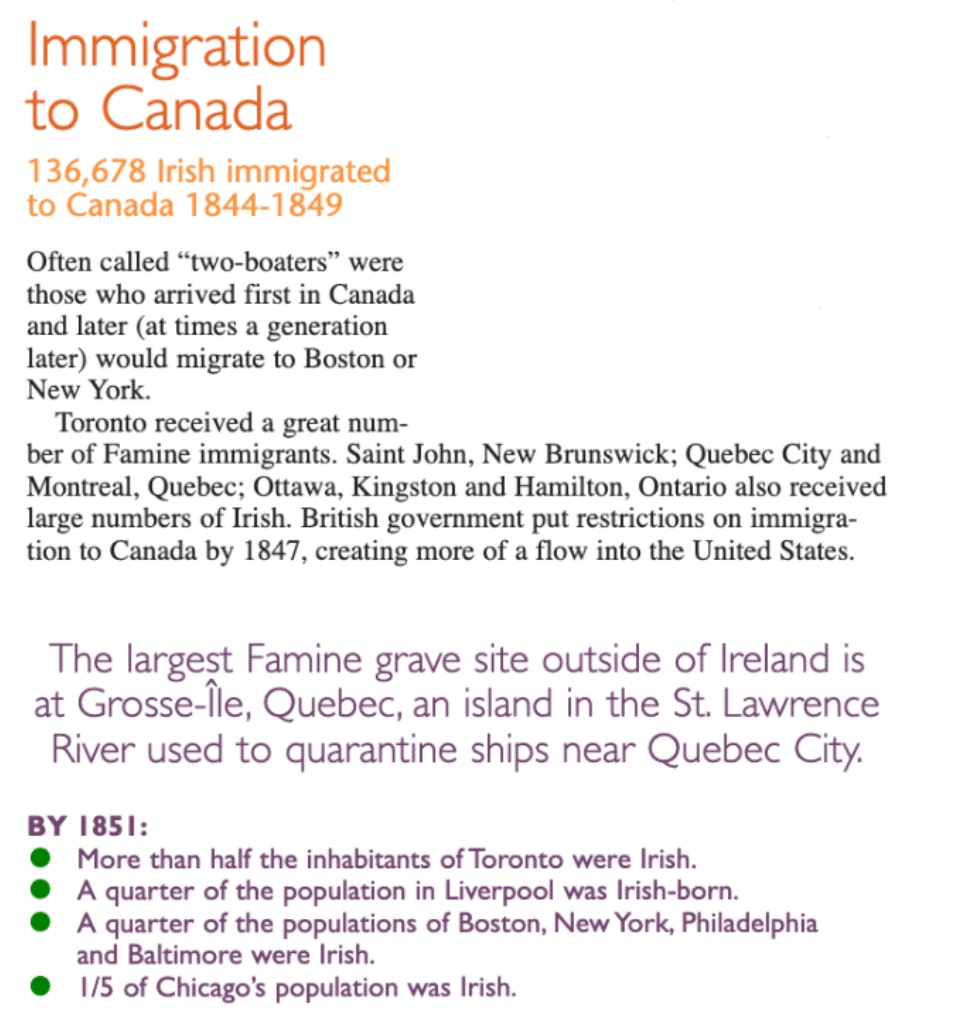
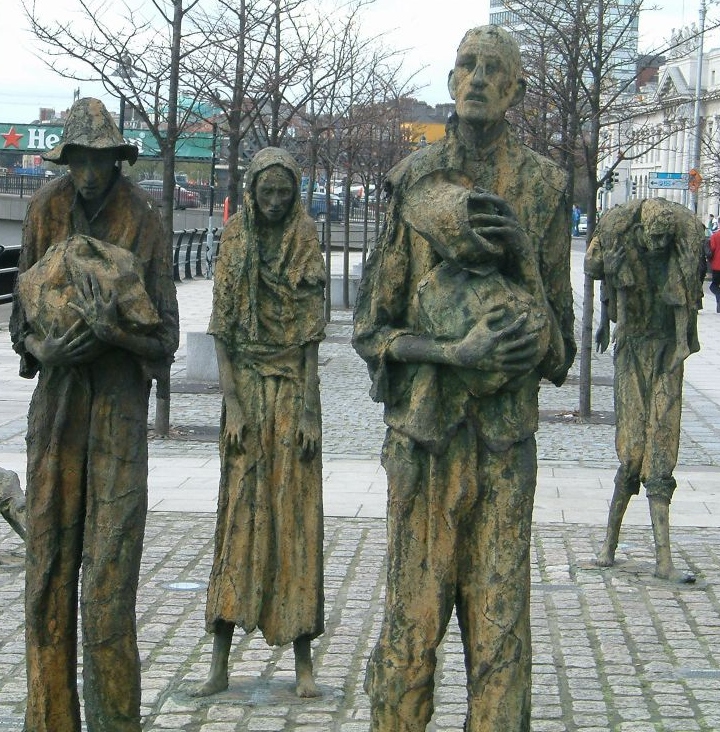
Very informative. A succinct perspective of the British government’s response to and management of the famine years.
A well explained overview of the many failed policies implemented at the time which exacerbated the problem despite the protestations from those within the British government/establishment who championed a more humane approach to address the dilemma in Ireland.
A more modern day expression can be applied in this instance RE: corn dealers, merchants who manipulated the abundant food supply: If you want to find the answers, “Follow the money.”
It’s sad to read it again! Despite the fact that I left Ireland at 17, I was already familiar with Poor Houses like the old ruin of one about 8 miles from my home in Ballinrobe, County Mayo, and ones in other counties. However, it’s an excellent educational article for which the Irish America Magazine deserve credit as well as the editor.
Sincerely, Harry Dunleavy